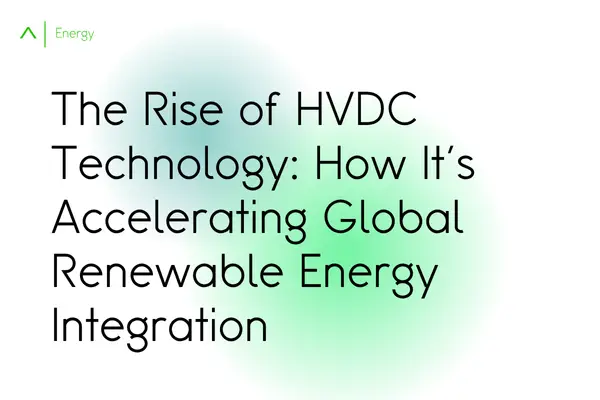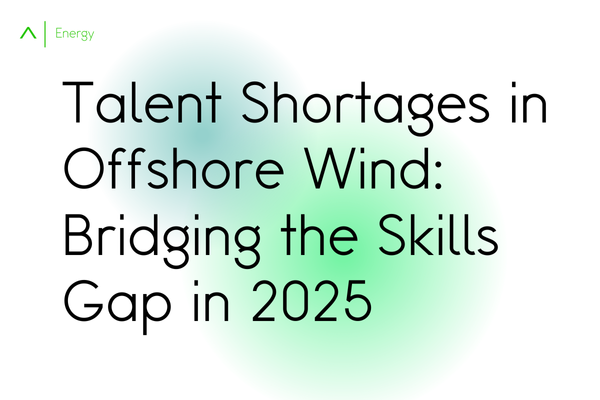Lessons from Europe's HVDC Projects: What the Rest of the World Can Learn About Building Critical Infrastructure Talent
18 Jul, 20254 minsEurope's pioneering HVDC projects have become the blueprint for global energy infrastructure...

Europe's pioneering HVDC projects have become the blueprint for global energy infrastructure development. These massive undertakings offer crucial lessons not just in engineering and project management, but in developing the specialised talent required for critical infrastructure projects worldwide. The insights from projects like Viking Link, North Sea Link, and TenneT's 2GW Programme provide invaluable guidance for any nation embarking on large-scale infrastructure transformation.
The Viking Link Achievement: Engineering Excellence Through Collaboration
Viking Link's completion in December 2023 marked a watershed moment in HVDC development. As the world's longest onshore and subsea interconnector at 765 kilometres, connecting the UK and Denmark with 1.4GW capacity, the project demonstrated what's possible when European collaboration meets cutting-edge engineering expertise.
The project's success stemmed from meticulous supply chain coordination across multiple countries. Siemens Energy delivered converter stations, Prysmian provided turnkey cable solutions, and Balfour Beatty managed UK civil works. This international collaboration model has become the template for complex infrastructure projects globally, requiring professionals who can navigate diverse regulatory environments, technical standards, and cultural approaches.
For talent development, Viking Link demonstrated the importance of cross-border expertise. The project created demand for professionals who could work seamlessly across different national systems while maintaining technical excellence and project coherence.
North Sea Link: Pushing Technical Boundaries
The 1.4GW North Sea Link between the UK and Norway, stretching 447 miles at depths of nearly half a mile, established new benchmarks for subsea HVDC capability. The project's technical achievements in deep-water cable laying and extreme-environment engineering created expertise that's now being applied globally.
The success required specialists who understood both cutting-edge HVDC technology and the unique challenges of North Sea operations. These professionals developed skills in project management under extreme conditions, international regulatory coordination, and advanced marine engineering that are now in demand worldwide.
The project highlighted the need for professionals who can operate in challenging environments while maintaining the highest technical standards. This expertise is directly transferable to infrastructure projects in other demanding environments globally.
TenneT's 2GW Programme: Industrial Scale Innovation
TenneT's 14-system, 2GW programme represents industrial-scale HVDC deployment. Targeting completion by 2031, this initiative will add 28GW of offshore wind capacity across Dutch and German North Sea sectors. The programme's significance lies not just in its scale but in its systematic approach to supply chain development and standardisation.
The programme created demand for professionals who understand standardised HVDC solutions, mass production methodologies, and large-scale project coordination. These skills are directly applicable to infrastructure programmes worldwide, from India's massive HVDC expansion to the US grid modernisation initiatives.
The standardisation approach developed through TenneT's programme offers a template for other regions seeking to deploy HVDC technology at scale while maintaining cost-effectiveness and technical reliability.
Innovation Through Necessity: Technology Development
European HVDC projects drove technological innovation through practical necessity. The development of VSC technology, 525kV XLPE cables, and advanced offshore installation techniques emerged from real project requirements rather than laboratory research.
Viking Link pioneered the use of hydrogen fuel cells for off-grid construction power, eliminating the need for diesel generators. The Leonardo da Vinci cable-laying vessel, with its 7,000 and 10,000-ton rotating platforms, represented state-of-the-art marine engineering. These innovations required specialists who could adapt existing technologies to new applications under demanding conditions.
The innovation approach demonstrated that breakthrough technologies often emerge from addressing real-world project challenges. This lesson is being applied globally as other regions face their own unique infrastructure challenges.
Supply Chain Development: Creating Industrial Ecosystems
Europe's HVDC success required fundamental supply chain transformation. The projects drove investments exceeding $3.3 billion in new cable manufacturing facilities and converter production capacity. This supply chain development model offers crucial lessons for other regions.
The approach required professionals who understood both technical requirements and industrial development. Supply chain specialists, manufacturing engineers, and quality assurance professionals developed expertise in scaling production for massive infrastructure programmes. This knowledge is now being applied globally as other regions develop their HVDC capabilities.
Countries like India, China, and the United States are applying these supply chain development lessons to build their own HVDC manufacturing capabilities, reducing dependence on imports while building domestic expertise.
Multi-National Project Management Excellence
European HVDC projects demonstrated sophisticated approaches to multi-national project coordination. Projects like LionLink between the UK and Netherlands, and the planned Nautilus interconnector with Belgium, require coordination across different regulatory systems, technical standards, and operational cultures.
Success required project managers who could navigate complex international partnerships, legal frameworks that span multiple jurisdictions, and technical teams distributed across countries. These skills are increasingly valuable as infrastructure projects become more international in scope.
The multi-national coordination expertise developed through European projects is now being applied to international infrastructure initiatives worldwide, from cross-border transmission projects in Africa to interconnection projects in Southeast Asia.
Risk Management and Financial Innovation
European projects pioneered sophisticated risk-sharing mechanisms that enabled private investment in massive infrastructure. The cap-and-floor regime in the UK, framework agreements like TenneT's EUR30 billion deal, and innovative financing structures created models now being adapted globally.
These financial innovations required professionals who understood both infrastructure development and complex financial structuring. The expertise developed in creating bankable infrastructure projects under uncertain regulatory environments is now being applied to projects worldwide.
The financing models developed through European HVDC projects have become templates for infrastructure financing globally, particularly in emerging markets where traditional funding mechanisms may be insufficient.
Skills Development and Knowledge Transfer
European HVDC projects created comprehensive training and skills development programmes that other regions are now replicating. The combination of formal education, on-the-job training, and international collaboration developed a generation of HVDC specialists.
The UK's National HVDC Centre in Scotland exemplifies this approach, providing research and development capabilities while training the next generation of specialists. Similar centres are now being established globally, based on the European model of combining research, industry collaboration, and skills development.
This systematic approach to skills development ensures knowledge transfer and capability building that extends far beyond individual projects, creating sustainable expertise for long-term infrastructure development.
Standardisation and Interoperability
European projects drove standardisation efforts that now benefit global HVDC development. The focus on interoperability between different national grids, standardised technical approaches, and common operational procedures created frameworks being adopted worldwide.
The emphasis on multi-vendor systems, standardised interfaces, and common operational procedures required professionals who understood both technical integration and international standards development. This expertise is now crucial for HVDC projects globally.
International standards developed through European projects are being adopted by other regions, facilitating technology transfer and reducing development costs for new HVDC implementations.
Environmental and Sustainability Integration
European projects integrated environmental considerations from the outset, developing approaches to minimise ecological impact while maximising energy benefits. The emphasis on sustainability throughout project lifecycles created expertise in environmental impact assessment, sustainable construction practices, and long-term environmental stewardship.
This environmental expertise, combined with technical knowledge, created specialists who understand both infrastructure development and environmental protection. These skills are increasingly important as global infrastructure projects face stricter environmental requirements.
The environmental approaches developed through European HVDC projects are being adapted globally, particularly in environmentally sensitive regions where infrastructure development must balance economic needs with ecological protection.
Lessons for Global Implementation
- Early Supply Chain Engagement: European projects demonstrated the importance of engaging suppliers early and systematically developing production capacity. This approach is now being applied in the US, India, and China.
- International Collaboration Models: The multi-national partnership approaches developed in Europe provide templates for cross-border infrastructure projects worldwide.
- Systematic Skills Development: The comprehensive training and knowledge transfer programmes created through European projects offer models for building sustainable expertise globally.
- Technology Adaptation: The innovation-through-necessity approach demonstrates how real-world project challenges drive technological advancement.
- Financial Innovation: The sophisticated financing mechanisms developed for European projects enable private investment in large-scale infrastructure globally.
Global Application and Future Prospects
The expertise and approaches developed through European HVDC projects are now being applied worldwide. The United States is implementing similar multi-GW transmission programmes, India is deploying HVDC technology for renewable energy integration, and China continues expanding its ultra-high-voltage networks using lessons learned from European innovation.
The talent developed through European projects has become a global resource, with professionals trained on European HVDC projects now leading infrastructure development worldwide. This knowledge transfer ensures that the lessons learned through European innovation benefit global infrastructure development.
As the world races to deploy renewable energy infrastructure and modernise transmission networks, the lessons from Europe's HVDC projects provide a roadmap for success. The combination of technical excellence, international collaboration, and systematic talent development offers a template for infrastructure transformation that extends far beyond Europe's borders.
The future of global infrastructure development will continue to benefit from the expertise, approaches, and innovations pioneered through Europe's HVDC projects, ensuring that these lessons contribute to worldwide energy transformation and infrastructure modernisation.



